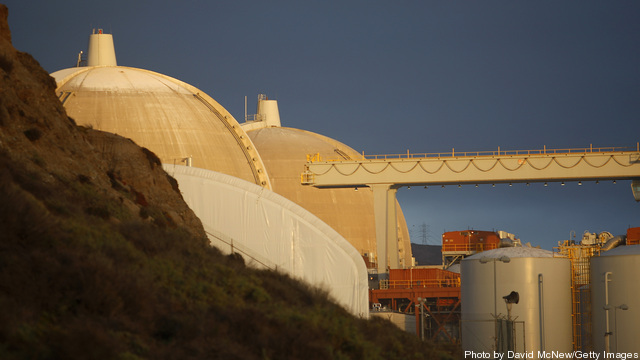There’s more trouble for carbon capture and more trouble for Southern Company, the big Atlanta-based utility holding company: South Mississippi Electric Power Association backed out of its plan to pump $600 million into the Kemper County Carbon Dioxide Capture and Storage Project in Mississippi for a 15 percent stake. Fitch reacted quickly. Fitch will review the ratings and Outlook for… Keep reading →
Southern Company
Sign up and get Breaking Energy news in your inbox.
We will never sell or share your information without your consent. See our privacy policy.State level regulators, like politicians, read the newspaper headlines, notice what is in their in-box and have a good sense of what their constituents like and dislike. This, more than anything else, explains why they seem reluctant to modify or nullify prevailing net energy metering (NEM) laws even when they realize that the status quo may be unsustainable… Keep reading →

More than two weeks have passed since Hurricane Sandy brought the Eastern Seaboard to a standstill. Although life is slowly returning to normal, Sandy joins a long series of painful reminders of how dependent 21st century America is on reliable electricity: it powers nearly every facet of our lives. The potential silver lining in the wake of Sandy’s devastation is the influx of interest in our outdated and inadequate transmission grid, highlighting long ignored issues from the benefits of buried transmission lines to the importance of an integrated, redundant, resilient grid – built to withstand even Sandy’s fury.
A robust and modern electric grid is also essential for taking advantage of America’s unmatched renewable energy resources. Wind and sunlight cannot be delivered to customers from their best sources – mostly remote areas and offshore – using railcars and pipelines like coal, oil, and gas; they need transmission lines. In the Southeast, where wind and solar are relatively scarce, transmission lines are critical for bringing cheap and abundant renewable resources from other regions. The Tennessee Valley Authority (TVA), which provides power to nearly all of Tennessee and other Southeastern areas, is now importing wind power from eight wind farms in the Midwest. Alabama Power, a subsidiary of Atlanta-based Southern Company, last year made one of the largest wind purchases ever from producers in Oklahoma. Keep reading →

When it comes to energy and politics, the United States is not what it appears. Deregulation of the power markets is one example. Some regions of the nation have developed robust power markets. Others regions do not and they don’t want it.
The regionalization of the power markets means there is no such thing as a national grid. According to The ISO/RTO Council, the United States has seven formalized power markets and vast regions where no markets exist at all. Approximately two-thirds of US consumers are served by the seven deregulated power markets. The objective of these markets is to provide buyers and sellers price discovery, liquidity, and non-discriminatory access to wholesale power. Keep reading →

Don’t ban coal for electricity generation.
That was the plea from utility officials and state regulators trying to cope with the flood of regulations now coming out of the Environmental Protection Agency. Keep reading →

A single Northeastern US state is preparing to miss out on growing export markets for woody biomass fuel production due to pending new regulation designed to lower carbon emissions. The decision would be a departure from the design of most regulations and markets designed to prevent global warming in Europe and the US.
Massachusetts is poised to adopt a regulation which, according to biomass experts, would keep forest products on the renewable energy sidelines. Keep reading →
 The San Onofre Nuclear Generating Station is seen from the beach along San Onofre State Beach on March 15, 2012 south of San Clemente, California.
The San Onofre Nuclear Generating Station is seen from the beach along San Onofre State Beach on March 15, 2012 south of San Clemente, California.
The head of the Nuclear Energy Institute yesterday said he was optimistic that California’s San Onofore nuclear plant would again start producing electricity and denied that the US industry was troubled by high costs and safety concerns after Fukushima. Keep reading →

It is easy to enumerate the challenges facing the utility sector over the coming decade, but participants in DNV KEMA’s fifth “Utility of the Future” Summit in Washington, DC today were optimistic about the opportunities to build on what many pointed out was a relationship of deep trust with consumers and regulators.
Southern Company Services CEO Susan Story grabbed the conference’s attention with an easy command of extensive facts about the largest vertically integrated US utility’s efforts to adjust to changing operating and technology environments. She balanced the deep dives with illustrative examples and a strategic view of her industry’s changing place in the world. Keep reading →
 Chairman of the Nuclear Regulatory Commission (NRC) Gregory Jaczko listens to his introduction before he delivers remarks at the Regulatory Information Conference on March 13, 2012 in Rockville, Maryland.The long-expected federal decision giving SCANA a license to build two new nuclear reactors in South Carolina came along with news that project has already encountered delays and cost overruns.
Chairman of the Nuclear Regulatory Commission (NRC) Gregory Jaczko listens to his introduction before he delivers remarks at the Regulatory Information Conference on March 13, 2012 in Rockville, Maryland.The long-expected federal decision giving SCANA a license to build two new nuclear reactors in South Carolina came along with news that project has already encountered delays and cost overruns.
The Nuclear Regulatory Commission approved the license for SCANA’s Summer station near Columbia, SC on Friday, seven weeks after approving a similar license for Southern Company’s Vogtle station near August, Georgia. The vote was again 4-1, with Chairman Gregory Jaczko again dissenting over the commission’s decision not to attach a specific provision requiring compliance with future post-Fukushima requirements. Keep reading →
 This file picture taken on February 28, 2012 shows workers walking at the emergency operation center of the stricken Tokyo Electric Power Co (TEPCO) Fukushima Daiichi nuclear power plant in Okuma, Fukushima prefecture.
This file picture taken on February 28, 2012 shows workers walking at the emergency operation center of the stricken Tokyo Electric Power Co (TEPCO) Fukushima Daiichi nuclear power plant in Okuma, Fukushima prefecture.
At the first anniversary of the March 11, 2011 Fukushima Daiichi nuclear accident, the nuclear industry outside Japan and central Europe is largely continuing as before the accident, says a World Energy Council report. Keep reading →


